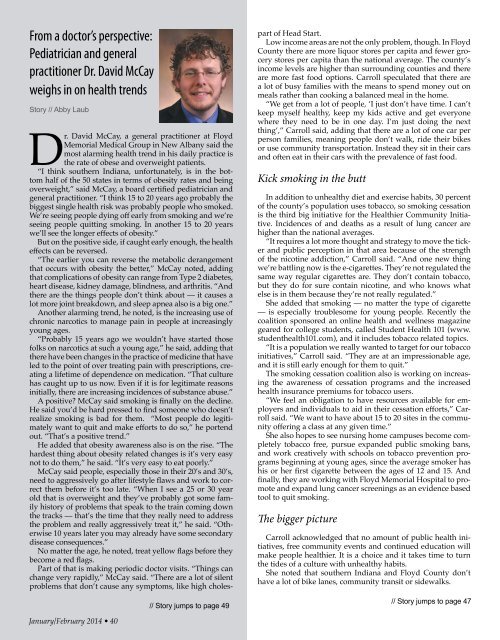Southern Indiana Living JanFeb 2014
Create successful ePaper yourself
Turn your PDF publications into a flip-book with our unique Google optimized e-Paper software.
From a doctor’s perspective:<br />
Pediatrician and general<br />
practitioner Dr. David McCay<br />
weighs in on health trends<br />
Story // Abby Laub<br />
Dr. David McCay, a general practitioner at Floyd<br />
Memorial Medical Group in New Albany said the<br />
most alarming health trend in his daily practice is<br />
the rate of obese and overweight patients.<br />
“I think southern <strong>Indiana</strong>, unfortunately, is in the bottom<br />
half of the 50 states in terms of obesity rates and being<br />
overweight,” said McCay, a board certifed pediatrician and<br />
general practitioner. “I think 15 to 20 years ago probably the<br />
biggest single health risk was probably people who smoked.<br />
We’re seeing people dying of early from smoking and we’re<br />
seeing people quitting smoking. In another 15 to 20 years<br />
we’ll see the longer efects of obesity.”<br />
But on the positive side, if caught early enough, the health<br />
efects can be reversed.<br />
“The earlier you can reverse the metabolic derangement<br />
that occurs with obesity the better,” McCay noted, adding<br />
that complications of obesity can range from Type 2 diabetes,<br />
heart disease, kidney damage, blindness, and arthritis. “And<br />
there are the things people don’t think about — it causes a<br />
lot more joint breakdown, and sleep apnea also is a big one.”<br />
Another alarming trend, he noted, is the increasing use of<br />
chronic narcotics to manage pain in people at increasingly<br />
young ages.<br />
“Probably 15 years ago we wouldn’t have started those<br />
folks on narcotics at such a young age,” he said, adding that<br />
there have been changes in the practice of medicine that have<br />
led to the point of over treating pain with prescriptions, creating<br />
a lifetime of dependence on medication. “That culture<br />
has caught up to us now. Even if it is for legitimate reasons<br />
initially, there are increasing incidences of substance abuse.”<br />
A positive? McCay said smoking is fnally on the decline.<br />
He said you’d be hard pressed to fnd someone who doesn’t<br />
realize smoking is bad for them. “Most people do legitimately<br />
want to quit and make eforts to do so,” he portend<br />
out. “That’s a positive trend.”<br />
He added that obesity awareness also is on the rise. “The<br />
hardest thing about obesity related changes is it’s very easy<br />
not to do them,” he said. “It’s very easy to eat poorly.”<br />
McCay said people, especially those in their 20’s and 30’s,<br />
need to aggressively go after lifestyle faws and work to correct<br />
them before it’s too late. “When I see a 25 or 30 year<br />
old that is overweight and they’ve probably got some family<br />
history of problems that speak to the train coming down<br />
the tracks — that’s the time that they really need to address<br />
the problem and really aggressively treat it,” he said. “Otherwise<br />
10 years later you may already have some secondary<br />
disease consequences.”<br />
No matter the age, he noted, treat yellow fags before they<br />
become a red fags.<br />
Part of that is making periodic doctor visits. “Things can<br />
change very rapidly,” McCay said. “There are a lot of silent<br />
problems that don’t cause any symptoms, like high choles-<br />
// Story jumps to page 49<br />
part of Head Start.<br />
Low income areas are not the only problem, though. In Floyd<br />
County there are more liquor stores per capita and fewer grocery<br />
stores per capita than the national average. The county’s<br />
income levels are higher than surrounding counties and there<br />
are more fast food options. Carroll speculated that there are<br />
a lot of busy families with the means to spend money out on<br />
meals rather than cooking a balanced meal in the home.<br />
“We get from a lot of people, ‘I just don’t have time. I can’t<br />
keep myself healthy, keep my kids active and get everyone<br />
where they need to be in one day. I’m just doing the next<br />
thing’,” Carroll said, adding that there are a lot of one car per<br />
person families, meaning people don’t walk, ride their bikes<br />
or use community transportation. Instead they sit in their cars<br />
and often eat in their cars with the prevalence of fast food.<br />
Kick smoking in the butt<br />
In addition to unhealthy diet and exercise habits, 30 percent<br />
of the county’s population uses tobacco, so smoking cessation<br />
is the third big initiative for the Healthier Community Initiative.<br />
Incidences of and deaths as a result of lung cancer are<br />
higher than the national averages.<br />
“It requires a lot more thought and strategy to move the ticker<br />
and public perception in that area because of the strength<br />
of the nicotine addiction,” Carroll said. “And one new thing<br />
we’re battling now is the e-cigarettes. They’re not regulated the<br />
same way regular cigarettes are. They don’t contain tobacco,<br />
but they do for sure contain nicotine, and who knows what<br />
else is in them because they’re not really regulated.”<br />
She added that smoking — no matter the type of cigarette<br />
— is especially troublesome for young people. Recently the<br />
coalition sponsored an online health and wellness magazine<br />
geared for college students, called Student Health 101 (www.<br />
studenthealth101.com), and it includes tobacco related topics.<br />
“It is a population we really wanted to target for our tobacco<br />
initiatives,” Carroll said. “They are at an impressionable age,<br />
and it is still early enough for them to quit.”<br />
The smoking cessation coalition also is working on increasing<br />
the awareness of cessation programs and the increased<br />
health insurance premiums for tobacco users.<br />
“We feel an obligation to have resources available for employers<br />
and individuals to aid in their cessation eforts,” Carroll<br />
said. “We want to have about 15 to 20 sites in the community<br />
ofering a class at any given time.”<br />
She also hopes to see nursing home campuses become completely<br />
tobacco free, pursue expanded public smoking bans,<br />
and work creatively with schools on tobacco prevention programs<br />
beginning at young ages, since the average smoker has<br />
his or her frst cigarette between the ages of 12 and 15. And<br />
fnally, they are working with Floyd Memorial Hospital to promote<br />
and expand lung cancer screenings as an evidence based<br />
tool to quit smoking.<br />
Te bigger picture<br />
Carroll acknowledged that no amount of public health initiatives,<br />
free community events and continued education will<br />
make people healthier. It is a choice and it takes time to turn<br />
the tides of a culture with unhealthy habits.<br />
She noted that southern <strong>Indiana</strong> and Floyd County don’t<br />
have a lot of bike lanes, community transit or sidewalks.<br />
// Story jumps to page 47<br />
January/February <strong>2014</strong> • 40

















